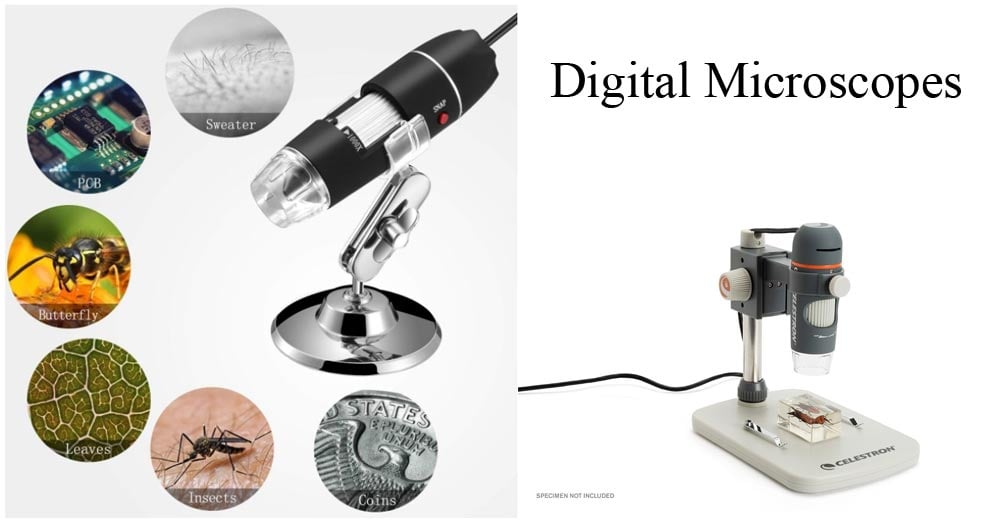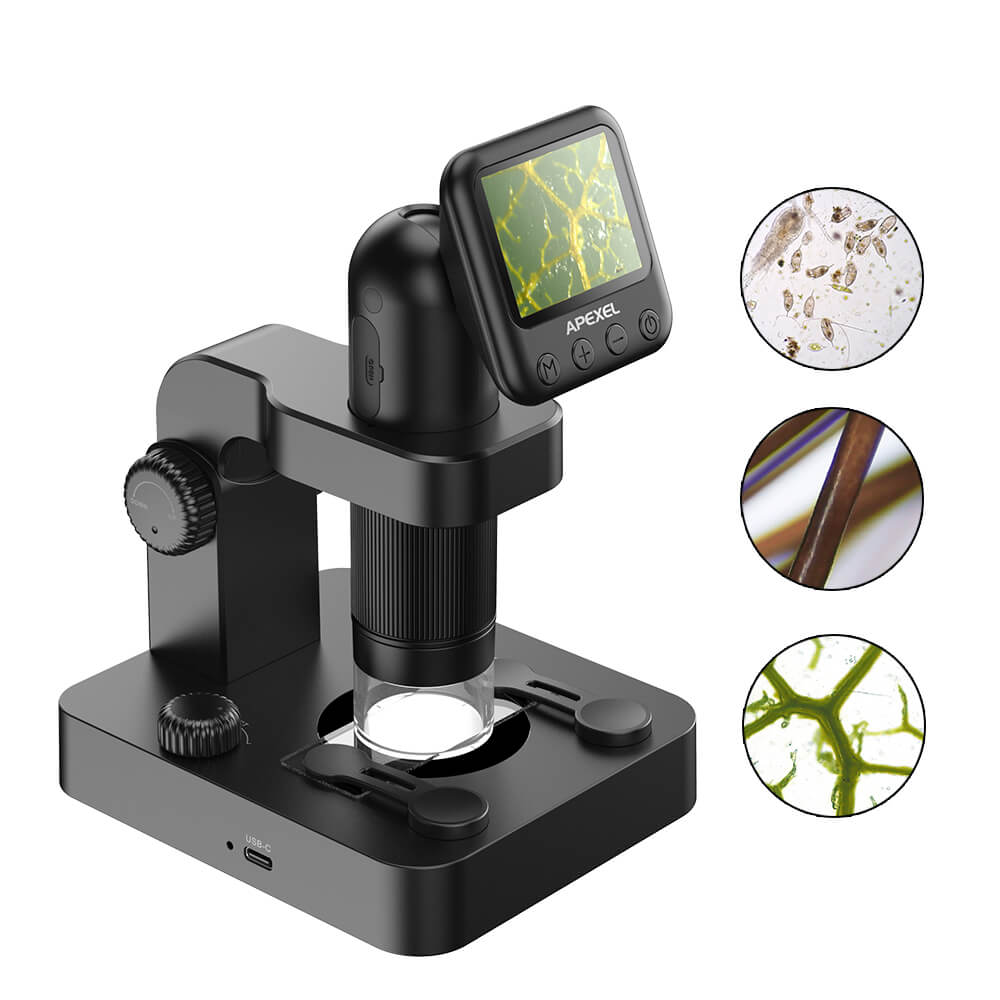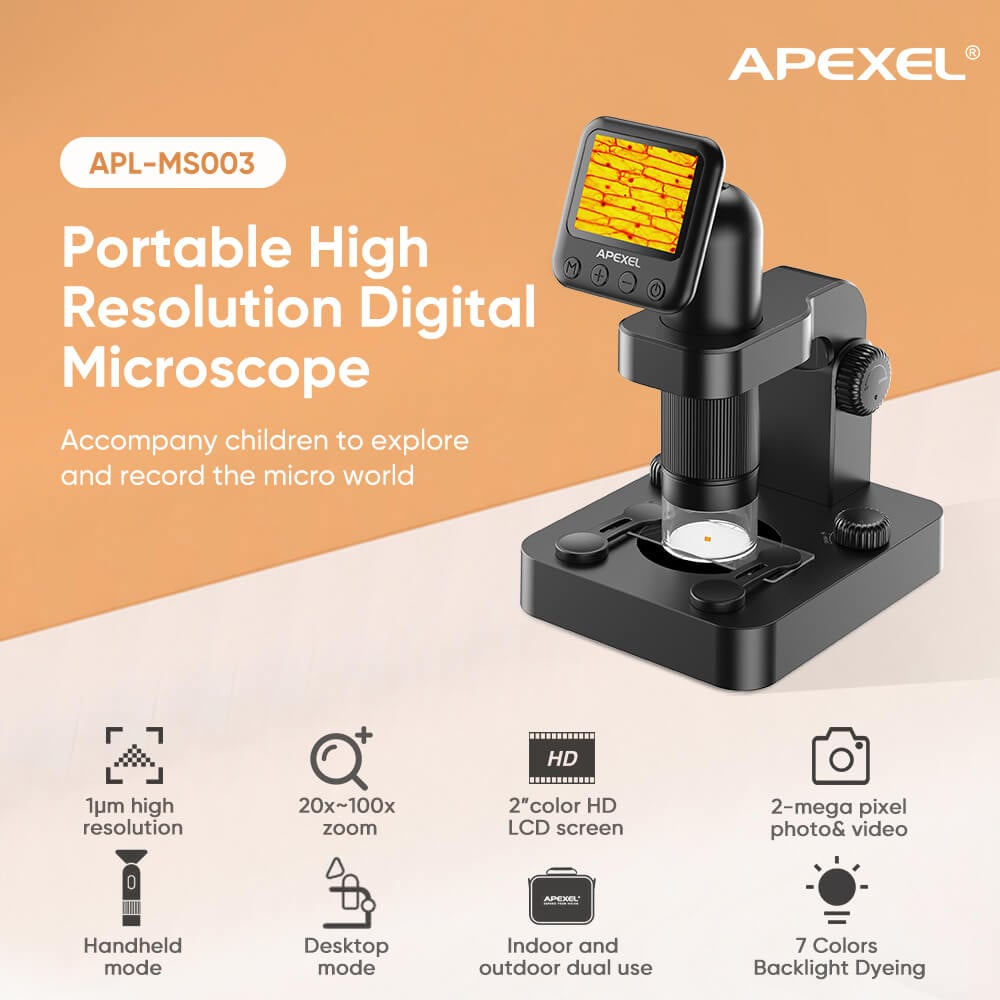A digital microscope is a modern microscope that lacks an eyepiece, an immense difference from the traditional optical microscope.
They have a digital camera which is the detector and the image output device. The display of the image is done on a computer screen or monitor, defining the microscope’s digital scope. This microscope’s light source is an inbuilt LED source as compared to the optical microscope, whose light source is accessed from outside the microscope through an eyepiece. Therefore, in the digital microscope, human optics access is eliminated since the entire apparatus has an image monitoring system. There are variants of the digital Microscope, including the USB digitalized microscopes which are very expensively industrialized digital microscopes, such as the Kohler illumination and the Phase-contrast Illumination, with installed webcams and macro lenses.
The first digital Microscope was manufactured in 1986 in Tokyo, Japan which constituted a control box and a lens connected to the camera. This is currently known as the Hirox Co. LTD. Because of its computerized connection. It can handle large digital data obtained from the digitalized camera installed within the microscope. In 2005, a more advanced digital microscope was manufactured, which did not require a computer; instead, it had an in-built unit that constituted a monitor and a computer. In 2015, however, a new digitalized microscope was also constructed, with an external computer with a USB connection, which expanded the longevity and speed of the computer. This reduced the external cable connections along with the size of the computer itself was reduced. They have image processing software that adjusts the image brightness, enhances the contrast and scale, and crops the image.

Image Source: Jiusion. and Celestron
Interesting Science Videos
Principle of a Digital Microscope
Digital Microscopes have the hardware and the software tools that allow its functionality in focusing and extracting an image from a specimen. Using installed software, the image from the specimen is captured that can be seen on the computer monitor screen. Depending on the software, the visualized images can be captured as still or motion videos, they can be recorded, edited, cropped, labeled, and saved. The software can also be used for measuring the image sizes, magnifying, and modification the image in several ways.
Parts of a Digital Microscope
The development of the digital Microscope takes into account two of its major functions. The Input and out functions and in this aspect, the digital microscope is made of two major parts;
- The hardware – this is majorly the analog part of the microscope, with a light source, the analog microscope, a camera, and the camera components. the Camera replaces the eyepiece of the traditional microscope. The image from the specimen gets focused on the camera and it is displayed on the computer monitor screen which is then stored and can also be processed.
- The software – This is the section of the microscope that has the camera drivers and the image processing software, which has organized units which include the viewer unit, brightness adjustment unit, image contrast unit, histogram equalization unit, image scaling unit and the image cropping unit. The image viewer unit continuously displays the specimen and captures the image from the microscope which is stored and processed depending on the user’s preferences. The image brightness adjustment unit enhances the brightness of the image depending on how much light is focused on the specimen. It controls the intensity of the light in pixels. The image brightness adjustment takes place in a grayscale transformation represented by an equation:
- Jo = Ji + C, (whereby Jo is the output image, Ji is the input image and C is the brightness adjustment constant). The C is set in positive value to increase the brightness and in negative value to reduce the brightness.
Types of Digital Microscopes
Depending on the function of the microscope and the users, different digital microscopes have been manufactured and labeled, with most of them being portable and easy to use. Use can vary from biomedical to industrial functions. These microscopes are combined with high-quality digital microscope cameras and a computer monitor screen.
- Biological Digital Microscopes: These are high magnification microscopes, that have a light source installed beneath the mechanical stage, with an objective of 4x-100x with halogen or LED illumination.
- Fluorescence Digital Microscopes: These are optical microscopes that use fluorescence and phosphorescence as their sources of light to generate an image.
- Inverted digital Microscopes: These are trinocular microscopes whose light source and the condenser are located at the top of the stage and the objectives, below the stage.
- Metallurgical digital Microscopes: They are designed to view metallic surfaces, wire circuits and/or opaque surfaces.
- Phase digital Microscopes: These can be inverted or upright microscopes used to observe specimens that are not stained which can either be live or dead.
- Stereo Digital Microscopes: They reflect light out of the specimen, and it is used to view electric components, artifacts, Plants, circuitry and Art.
- Polarizing Digital Microscopes: This is a special type of digital video camera with a combination of a high magnification lens and multi-ultra-bright LEDs. They can evaluate 3D structures and compositions of anisotropic specimens, using polarized light that forms light wave vibrations in a single direction.
- Digital USB Microscopes: These are microscopes that are connected to a computer via a USB connector. They have a permanently connected camera, unlike most of the digital microscopes whose cameras are connected with a C-mount adapter and can be removed.
- Handheld Digital Microscopes: They are very modern digital microscopes that are integrated into a handheld microscope system and used for inspection of surfaces and forensics.
- Portable digital Microscopes: They are small digital microscopes with installed wireless systems. they are used to view surfaces that are hard to reach and hence they are majorly used for medical surfaces, field inspection and for dermatological studies.
Uses of Digital Microscopes
They are used in a variety of fields from medical studies to industrial applications. these include:
- Cytological studies
- Brewing industries
- Water and Waste Treatment Industries
- Forensics
- Dental studies
- Fetal and embryonic Transplant studies
- Microsurgical procedures
- Transplantation procedures
Advantages of Digital Microscopes
- They provide high-resolution magnification of the images in pixels.
- It can tilt and provide 2D and 3D image measurements.
- They can store huge amounts of data, through imaging and recording movable and unmovable specimens
- They are one-stop operation machines since the visualize the images and provide an output of the images through the computer monitors.
- Some of them can be purchased at a cheap price.
Limitations of Digital Microscopes
- Some of them are expensive to manufacture and costly to purchase.
- They may require training for them to be used.
Example of Digital Microscopes
Apexel MS003 Digital Handheld Microscope
Apexel MS003 Digital Handheld Microscope can be used as a handheld or tabletop magnification tool. that can be a great portable companion in your home, outdoors, lab, school, work, or field.

The device and combines a 1/3″ 2.0MP CMOS sensor with an infrared-reducing optical system to provide high-resolution images and videos with a magnification range from 20x to 100x.
To provide bright and clear images, it offers a 3-LED illumination system with adjustable bright white output.
To offer flexibility in viewing visual data, the scope features a tiltable 2″ color TFT LCD screen, which can be tilted 75° to provide the most convenient viewing position. and Long-term observation is comfortable for your cervical spine. The LCD screen allows you to access a menu pad, which offers control over the operating modes and functions.
The microscope comes with an observation platform that can be raised and lowered. The light can be adjusted, providing different observation heights and the adjustment of the brightness and color temperature of the light, which allows you to achieve more professional observation work outdoors.

Apexel MS003 multifunction high-resolution Portable Digital Microscope Features :
- 20x-100x Zoom
- One-micron objects can be seen
- ED glass, crisp, clear, bright vision
- Full multi-layer coated lens
- Adjustable viewing angle
- Adjustable lift
- Adjustable lighting, color temperature, and brightness.
Buy Apexel MS003 Digital Handheld Microscope
Note: The Website may engage in affiliate marketing, which is done by embedding tracking links into the Website. If you click on a link for an affiliate partnership, a cookie will be placed on your browser to track any sales for commissions. As an associate, I earn from qualifying purchases.
References and Sources
- https://www.microscopeworld.com/c-442-digital-microscopes.aspx
- https://www.microscopeinternational.com/what-is-a-digital-microscope/
- https://en.wikipedia.org/wiki/Digital_microscope
- https://www.leica-microsystems.com/products/digital-microscopes/
- https://www.microscope.com/education-center/five-things-you-should-know/about-digital-microscopes
- ireflyglobal.com/gt825-5mp-polarizing-digital-microscope/

hi
please send the construction , working and function of trinocular microscope
didgital microscope is monocolar. The eyepiece is replaced by a camera.